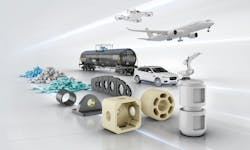High-Performance Plastics: The Value and Challenges of High-Volume Precision Molding
In today’s fast-paced world—where technological advances and human innovation are constantly evolving—the demand for components to perform better in terms of load, speed or temperature can be seen across industries. High-performance plastics (HPPs) serve as reasonable replacements for metals in many applications and allow the use of polymers where they would otherwise be impractical. HPPs can withstand extremely elevated temperatures, offer excellent mechanical properties and good wear resistance with relatively little friction, as well as demonstrate superior chemical resistance and compatibility.
There are various types of HPPs that can be manufactured in different ways. Many can be injection molded, and these high-performance thermoplastics allow for unique and complex geometries that otherwise must be machined.
READ MORE: Make it Standard: How Stocking Standard Products Benefits both OEM and Supplier
The use of high-performance thermoplastics can significantly reduce time and expense during design, prototyping and manufacturing. They are recyclable, which can cut down on waste, and their ability to bond to differing materials enables the creation of hybrid structures. Additionally, HPP parts are lighter than their steel counterparts so applications like automotive require less energy to function.
Is This the PEEK?
Thermoplastics and HPPs include a range of materials, including:
- PAEK (polyaryletherketone)
- PEI (polyetherimide)
- PEEK (polyetheretherketone)
- PPS (polyphenylene sulfide)
- PEKK (polyetherketoneketone)
- PPA (polypthalamide)
- PEKEKK (polyetherketone etherketone ketone)
- PPSU (polyphenylsulfone)
- PBI (polybenzimidazole)
- POM (acetal homopolymer)
- PA (polyamide)
- PBT (polybutylene terathalate)
Additives further enhance the performance of HPPs based on application needs. For example, carbon or glass fiber stiffen materials, while polytetrafluoroethylene (PTFE) and graphite lower friction levels and improve wear resistance. This makes HPPs ideally suited for use in the automotive, healthcare, chemical transportation, industrial automation, aerospace and semiconductor industries.
Overcoming Challenges via Tooling, Thermal Management
Producing components with HPPs, especially when they incorporate additives, present challenges related to tooling, temperature and part shrinkage. High-performance plastics are highly abrasive on press components, so the presses are often fitted with custom-designed screw and barrel systems to reduce wear and extend life for improved process capability. Due to the molecular chemistry of HPPs, material flow is challenging in multi-cavity tools.
To successfully produce components, molding needs to be at very high temperatures. A press molding a component in standard polymers runs at a melt temperature between 392 to 527°F (200 to 275°C). Presses for HPPs reach up to 797°F (425°C). Maintaining the temperature of all mold parts is difficult so programmable thermal management systems using treated soft water can be installed to successfully run water at 440°F (227°C).
How Fillers, Additives Affect Performance
A range of fillers and additives that can improve mechanical performance include:
- Dyes—influence color
- Mineral fillers—improve stiffness and dimensional stability
- Glass fiber—improve general performance in all characteristics
- Long fiber—good mechanical performance for specific applications
- Carbon fiber—lightweight, stiff and extremely high load-bearing capability
- Aramid fiber—similar to glass fiber, but less abrasive on mating assembly surfaces
The mechanics of thermal management for thermoplastic molding are also complex. Controlling the temperature of the tool helps ensure that the material has the correct mechanical characteristics and that part crystallinity and cycle times are not negatively affected. Proper cooling is especially critical for high-precision parts that are flat because they are prone to warpage.
READ MORE: Spotlight on Sealing Solutions for Fluid Power and Off-Highway
Another challenge related to temperature is part shrinkage. When a part cools to room temperature, it changes volume. Designing a tool with optimum cooling while considering part shrinkage takes in-depth knowledge by experienced engineers to overcome multiple challenges.
Tightening Tolerances for Critical Automotive Component
An automotive customer asked Trelleborg Sealing Solutions to improve the performance and specification of a polyetheretherketone (PEEK) hydraulic seal. Trelleborg already manufactured the seal with tight tolerances, but the customer asked for the tolerance to be cut in half and made repeatable for high volumes.
Using a precision 16-cavity high-volume production tool, Trelleborg controlled the length of the seal within 25 microns of the customer’s specifications. The challenging tolerance was maintained on external part dimensions where the polymer shrinks away from the tooling. Expert development of the process, tool design and material enabled the sealing solution provider to maintain a quality non-conformance level of zero parts per million (PPM) on this critical component.
Some Characteristics of High-Performance Plastics
- Suited to high-volume production
- Elevated operating temperatures
- Possible to achieve high precision and tight tolerances
- Outstanding chemical resistance
- Low friction
- Suited to high PV applications (pressure times velocity)
- Sealing where elastomers are not suitable, for instance small molecule media such as hydrogen
- Ideal for rotating applications
- Suitable for applications with high-speed movement where low friction is a key characteristic
- Can provide noise, vibration and harshness (NVH) reduction
- Offer electrical insulation or conductivity
- Can give thermal insulation
End Goal: Offer OEMs High Quantity of Tight-Tolerance Parts
Components suppliers who invest in world-class tooling and understand how to navigate the challenges of injection molding HPPs can offer original equipment manufacturers (OEMs) parts with tight tolerances at high quantities. Some suppliers can offer a full suite of services related to thermoplastics, including design assistance, feasibility and prototyping for commercial products, quality systems and facilities optimized for maximum flexibility in meeting the unique requirements of customers.
Variables for Holding Tight Tolerances
Holding tight tolerances when injection molding high-performance plastics takes experience and requires special considerations:
Part design. Overall part size and geometry impact tolerances and should be evaluated early in the design phase. The shape of the part impacts how the material flows and the joint where the material comes together, called a knit line.
Wall thickness. While thin-walled sections are relatively easy to control, thick-walled sections present some challenges. In thick-walled sections of a mold, the outer laminates of the material harden first while the center remains molten. The higher volumetric shrink may result in voids, collapsed sections or warp when the part finishes cooling.
Gating. Customers may have specific requirements on gating locations, especially for cosmetic products where clean edges are desired. Gating requirements affect how a mold is filled, therefore potentially impacting tolerance and final shape.
Temperature control. Tool cooling and thermal management is extremely important because it effects the behavior of the resin. Variable temperatures throughout a tool are common and a balancing act is required to control the final product.
Processing steps. Being mindful of the three main steps in the injection molding process will help yield the desired results:
- Fill. During this first stage, molten plastic material flows through the entire cavity.
- Pack. After filling, pressure is applied to the system to push additional plastic into the mold and against the walls. Poor packing can result in misshapen parts and dimensional instability.
- Cool. During this stage, the part cools in preparation for ejection. This step is critical for avoiding part warpage and for achieving the desired part properties and dimensional stability.
About the Author

Dan McArdle
Business Development Director, Technology and Innovation, Trelleborg Sealing Solutions
Dan McArdle has been the business development director, technology and innovation, Trelleborg Sealing Solutions for the past nine years. Throughout his time at Trelleborg, McArdle has served in multiple roles, including technical, program management and business development. He holds a BS in engineering and an MBA from Marquette University.

